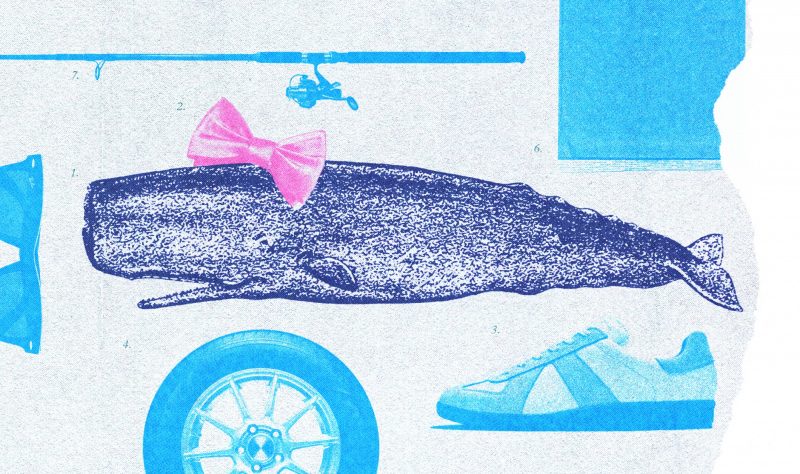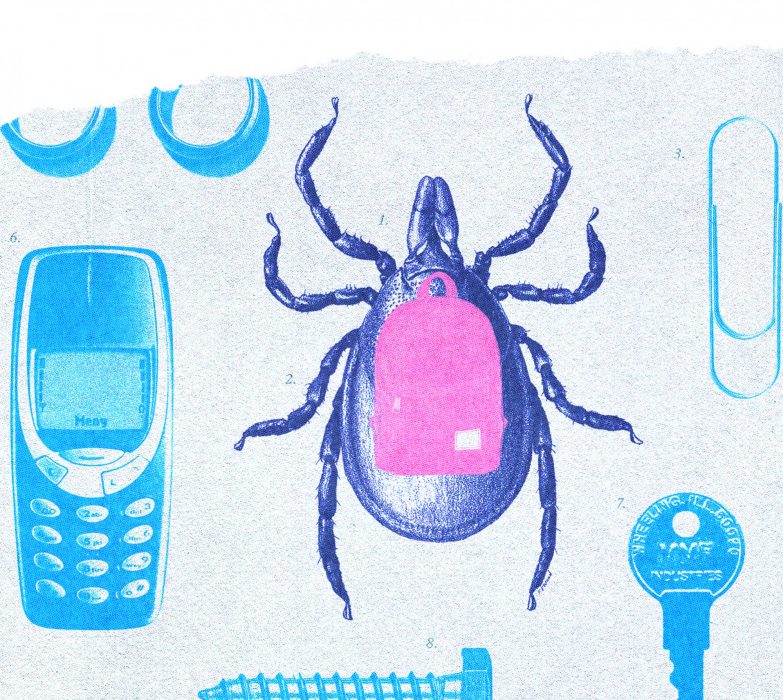It slammed to the ground like a defeated wrestler. This massive animal taken down in the snow by a hammock chair.
My wife saw the shadow first. A moving pitch of black near the oak tree from which this crocheted rope chair hung in homage to lazy summer afternoons. It was from the window of our Winnipeg home in the faint glow of dawn that we saw the stag, its antlers ensnared in the hammock’s netting. The beast looked exhausted, yet it found strength to thrash about, desperately leaping toward freedom. But the chair yanked it back and the animal whomped to the ground, over, and over again.
Hours later a conservation officer arrived, but by then the deer had ripped the chair’s tether from the tree and hobbled away, tripping with every step over the net it dragged from its head.
The officer said the week prior he was called about a deer walking around our Charleswood neighbourhood with a bubblegum-coloured seat lodged between its antlers.
The officer said he’d track the animal, which was likely eating acorns in our yard and didn’t see the hammock that had hung for years without incident. Just like the swing next to it, I mentioned. Was it a pink child’s swing, he asked? It was then I noticed our swing, too, was gone. The officer said the week prior he was called about a deer walking around our Charleswood neighbourhood with a bubblegum-coloured seat lodged between its antlers. I deflated, in shame, mostly. He assured me it wasn’t my fault, telling me that humans need to learn to live with deer, and deer with humans. Occasional trouble is inevitable, he said.
It was a passing remark he provided to fill a silence, but it was eerily prophetic: a few days later COVID-19 introduced itself to the world. Given the suspected source of today’s most urgent health challenge—likely a bat or pangolin somewhere in China—that final assertion should give us pause. Human and animal encounters can have consequences we cannot see for years, or decades, but come they do because every action we have collides with the natural world. As famed naturalist Sir David Attenborough put it: we are not apart from the natural world, we are a part of the natural world.
Is it wrong to love some animals more?
“Do not let moose lick your car.” The electronic sign in Jasper National Park is made “cute” in social media posts but it offers a serious message. Moose need salt in their diet and they’re learning that road salt clinging to a car in winter is an easy way to get a fix, but moose and cars are not a good mix.
People love moose. So, are a few licks okay—just to take a great pic? (Besides, how does one stop a moose from licking a car?)
In his book Wild Ones, journalist Jon Mooallem notes that moose are 76 times more popular than opossums. But would that change if people knew opossums ate the very ticks that can infect us with Lyme disease?
Our love of animals and our views of “wilderness” are formed through designed experiences, Mooallem argues. Think of zoo maps: UM geographers Mary Benbow and Bonnie Hallman once collaborated on a study that examined how zoo maps impact our understanding of biodiversity and influence our opinions of animals. Maps showing a gorilla bearing its teeth and beating its chest make you think it is ferocious, when in reality it’s a sensitive and nurturing being.
People may care about certain animals more than others. It’s a condition some biologists refer to as “fubsy.” We tend to prefer creatures that resemble our infants: big eyes, awkward, chubby.

All collages by Manny Berkal-Sarbit
In 1985, a 40-foot humpback whale captivated the public when it swam into the San Francisco Bay area to what would surely be its demise. Humphrey, as the wide-eyed cetacean was dubbed, was eventually lured out to sea through recordings played from a fishing boat, and 5,000 people flocked to the water’s edge to watch his release. Huzzah indeed, but, those megafauna lovers tromped through the only patch of habitat for the critically endangered lange’s metalmark butterfly. Fubsy.
Squashing butterflies aside, this fubsian behaviour has larger repercussions. These biases creep into funding. Over the last 25 years, a 2017 article in PLOS ONE reports, climate change has sparked reams of research on biodiversity, but most of these studies focus on vertebrates, snubbing many spineless creatures.
Perhaps COVID-19 will jolt this alignment anew as we continue to realize that unfubsy creatures help drive biodiversity, which in turn, lowers the risk of novel pathogens spilling over from the wild into humans.
“When you talk about conservation,” UM entomologist Kateryn Rochon says, “the conversation stops at parasites because nobody values parasites. I can get funding to work on ticks that have an impact on human health and animal health if it has an economic impact. But the groundhog tick is of interest to no one. It might be endangered—I don’t know. Most ticks are not studied because you can’t get funding to do it.”
The Dalai Lama said small things have great power, and if you disagree, try falling asleep with a mosquito in the room.
What are our cities doing to animals?
Mammals that live in and around urban centres are less able to adapt to a changing environment, UM biological sciences graduate student Chloé Schmidt reported in her February 2020 study. This is because, compared to their more wild counterparts, mammals such as racoons were found to have smaller, isolated populations, which lowers their genetic diversity and hinders their ability to adapt to environmental changes. So, how can humans help? Animal bridges, like the one in Banff National Park, are a start. They allow animals to safely cross over highways to new areas. There are also bridges designed for crabs and squirrel gliders, and tunnels for turtles and penguins.
How is a tiny invertebrate both our friend and foe?
A stuffed tick, silver tick earrings a friend gifted her, and a quilt her knitting group made that features her beloved arachnid. It must be easy to shop for Rochon.
The associate professor in the Faculty of Agricultural and Food Sciences began her studies interested in fleas, but then she learned that winter ticks, which are just over one centimetre long at their plumpest, can kill a moose. Although these ticks feed in clumps of thousands and can drain a moose of its blood, most moose die because the ticks change the mammal’s behaviour—driving it to scratch itself to death in winter. That hooked her.
Today, Rochon is one of the foremost experts in these miniscule carnivores and how they spread disease, and she has wondered, in various degrees of seriousness and jest, if she should brand herself “Dr. Tick Chick” to help disseminate her research and public health advice, like the viral video she made on how to safely remove one.
Ticks make a good case for anti-fubsyness.
Depending on who you ask, there are anywhere from 867 to 907 species of ticks in the world (with 40 in Canada) and we know very little about most of them because—as we’ve determined—parasites have few friends.
Agreed, the disease-vector thing is a turnoff, as is the way they crawl up your leg. But given our recent collective re-awakening to the importance of knowing about diseases lurking in the wild, we should embrace knowing and caring more about these tiny ecological cogs.
“If you want to know about natural reservoirs of disease, local research is crucial,” Rochon says. “Manitoba is not the same as Southern Ontario, for instance. Our mice are different. Our voles are different. How and where they stay in the environment is different. Their immune systems differ and so what strains of bacteria would persist in the environment and spread through ticks would be different.”
Manitoba is also blessed with a geography that allows for three or four major flyways—migrating bird highways—to pass over us, and riding on these birds are ticks that may carry diseases. Indeed, this is likely how the blacklegged tick—the vector of Lyme disease, as well as Anaplasmosis, Babesiosis and Powassan virus—arrived.
“We’re getting diverse strains of infectious bacteria here because of these flyways,” Rochon says. “Things are kind of spicier up here compared to down south and we don’t know what this creates. It could be a dilution effect: Because so many potentially infectious strains come in here, no single one can really be dominant. Or it could be we get more chances of nastier ones. It’s too early to know.”
And let’s be fair: creatures of fubsian beauty carry and enable a lot of diseases too—like the white-tailed deer hanging around backyard swing sets. They aide and abet legions of blacklegged ticks yet so few of us are willing to call them out on it, and instead we gasp adoringly at the sight of their big brown eyes. Such chicanery!
How else are we creating new collisions among our species and theirs?
Ecosystem balance is about timing. And climate change and human activity continually disrupt the time and place of natural events. Take purple martins.
UM’s Avian Behaviour and Conservation Laboratory (ABC Lab) published a paper in November 2020 showing that artificial light at night impacts the timing of spring migration of Progne subis, dashingly feathered birds that are the size of your outstretched hand.
Reyd Smith, the student who led the work, attached sensors to martins that overwintered in the Brazilian rainforest. The birds roosting nearest the brightest human lights, she learned, began their 9,000-km-return-journey to Canada eight days ahead of schedule. That’s a significant amount of time when you consider how, for millennia, these birds have exquisitely timed their migration to coincide with the emergence of insects up north. Imagine the stress of walking 9,000 kilometres to your favourite restaurant only to be told your table would not be ready for a week.
Oddly, there is a hope in this: climate change is causing insects to hatch earlier, and the purple martins who follow regular itineraries are beginning to arrive too late, missing out on the feast. So biological sciences associate professor Kevin Fraser, head of ABC Lab, is working on a separate project to explore if, and how, a field experiment that exposes chicks to alternative light cues can help the swallows adjust faster to this new reality than evolution would allow.
For Rochon’s subjects, climate change is good business. Her research has found that it is enabling significant territory expansion across the Prairies of American dog ticks and the Rocky Mountain wood tick, both of which carry bacteria that can—though statistically unlikely, at least for now—infect humans. (And in the struggle between moose and winter tick, climate change may favour the tick with shorter winters and milder springs that increase their reproductive chances.)
Ticks find new lands not only on the wings of birds, but by following humans too. When ranchers move north to less expensive lands, for example, ticks follow along our roadways and paths and on us, says Rochon.
“So people do move ticks around and this is a potential situation where you’re bringing a disease vector into an area where it wasn’t before. That’s never good.”
Rochon says we need to be active thinkers when we’re exploring the natural world. She was speaking about the need to check often for ticks when enjoying the wild—especially the small nymphs that are about the size of a poppy seed—so that you can prevent disease transmission. But it’s clear that her message is applicable to the bigger picture: We need to change our behaviour and our views.
“People who do field work in nature see themselves as the intruders. We understand that we are encroaching,” she says. “When you have a life that is disassociated with that, you see yourself as having a right to it. And that’s a big difference.”







I enjoyed your article, thanks!